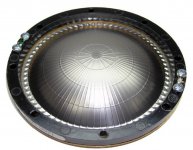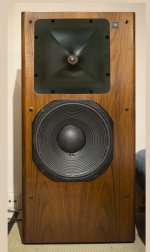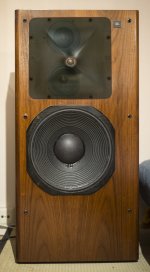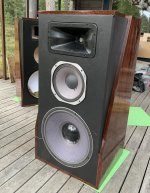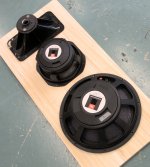Hypes are the expression of our urge to have something meaningful in life, I think we should apprehend them! 😉 They are very cute and give us a good feeling, while real knowledge will always let us down. Remember my words when your days are the bleakest.
I also wonder: If I use a woofer with only about 93db efficiency, does a waveguided CD makes sense at all, if I could also use a waveguided dome tweeter? Because your examples showed some fairly well controlled directivity without a CD. I was just thinking to downscale my speaker project from a 12" to a 10" woofer and I will loose efficiency on this way, which may reduce the need for high SPL compression drivers.
I also wonder: If I use a woofer with only about 93db efficiency, does a waveguided CD makes sense at all, if I could also use a waveguided dome tweeter? Because your examples showed some fairly well controlled directivity without a CD. I was just thinking to downscale my speaker project from a 12" to a 10" woofer and I will loose efficiency on this way, which may reduce the need for high SPL compression drivers.
I think it does if you want to get down really low. Easy to get a CD that gets down below 800hz at these volumes. getting a 1 inch dome down to 1k is hard...
but then you have a big speaker 😛
but then you have a big speaker 😛
I've actually found the opposite: it's generally easier to get a dome tweeter to play below 1khz than a compression driver.
A 1" compression driver will generally have a surface area of about 15cm^2
A 1" tweeter will generally have a surface area of about 5.07cm^2
The big difference is that dome tweeters have a surround, so the xmax can be as much as 3-6x higher.
Similar to how domes outperform ribbons: the ribbon has higher efficiency, but the dome's displacement advantage wins if you need a low xover.
Another great thing about domes on waveguides is that it's not too hard to get as much as 6-10dB of gain from about 500hz - 10khz.
Of course, I'm not saying that domes are *always* the ideal solution, just saying that they can be surprisingly competitive. If maximum SPL is the goal, a compression driver will generally walk all over a dome because the range from 1500hz to 6khz is just SO LOUD. Things get tricky when you compare the octave of 750Hz to 1500Hz though.
Of course if you have one of those fancy JBL beryllium compression drivers with a diamond surround, well yeah, then it's game over lol
A 1" compression driver will generally have a surface area of about 15cm^2
A 1" tweeter will generally have a surface area of about 5.07cm^2
The big difference is that dome tweeters have a surround, so the xmax can be as much as 3-6x higher.
Similar to how domes outperform ribbons: the ribbon has higher efficiency, but the dome's displacement advantage wins if you need a low xover.
Another great thing about domes on waveguides is that it's not too hard to get as much as 6-10dB of gain from about 500hz - 10khz.
Of course, I'm not saying that domes are *always* the ideal solution, just saying that they can be surprisingly competitive. If maximum SPL is the goal, a compression driver will generally walk all over a dome because the range from 1500hz to 6khz is just SO LOUD. Things get tricky when you compare the octave of 750Hz to 1500Hz though.
Of course if you have one of those fancy JBL beryllium compression drivers with a diamond surround, well yeah, then it's game over lol
Attachments
Last edited:
New BMS 5530/5531 ND 1" driver can be crossed at 850Hz if you have two. I assume that you can get away with just one if you play at home.
But witch waveguid to use. JBL M2 waveguid throut is to big.
$162 on ebay
http://www.bmsspeakers.com/fileadmin/bms-data/curves/compression_drivers/neodymium/bms_5530_curves.jpg
But witch waveguid to use. JBL M2 waveguid throut is to big.
$162 on ebay
http://www.bmsspeakers.com/fileadmin/bms-data/curves/compression_drivers/neodymium/bms_5530_curves.jpg
Last edited:
Eminence N314X-8 $349.99
Usable Frequency Range 500Hz-20kHz
Recommended Crossover 800 Hz / 12 dbkHz
N314X-8 - Drivers | Eminence Speaker
An other wold be JBL D2430K. This is now $344 so is there a pricewar.
reconingspeakers.com/jbl-d2430k
Usable Frequency Range 500Hz-20kHz
Recommended Crossover 800 Hz / 12 dbkHz
N314X-8 - Drivers | Eminence Speaker
An other wold be JBL D2430K. This is now $344 so is there a pricewar.
reconingspeakers.com/jbl-d2430k
Last edited:
The problem is the size of the waveguide. IIRC, Geddes said the much cheaper B&C DE250 can be crossed <1kHz with a reasonable reserve when it comes to xmax, target 110 dB. But you will need a huge/deep waveguide to achieve pattern control and this will get tricky if a boxy design is intended.
So then if we are fighting these X overs ranges on how low we can go I am sort of left with the conclusion a 3X way is still better.
With something like the Large Dome used in the Neumanns (ATC?) and suitable dome tweeter it seems on paper a better behaved model.
Correct me of course if i am wrong as I am here listening.
With something like the Large Dome used in the Neumanns (ATC?) and suitable dome tweeter it seems on paper a better behaved model.
Correct me of course if i am wrong as I am here listening.
But Neumann KH 310 is not exactly with out a wave guide and holds up decently well. Sure not a true horn or M2 style but not flush mount either.
End results all that matters in performance in the end.
End results all that matters in performance in the end.
I've actually found the opposite: it's generally easier to get a dome tweeter to play below 1khz than a compression driver.
A 1" compression driver will generally have a surface area of about 15cm^2
A 1" tweeter will generally have a surface area of about 5.07cm^2
The big difference is that dome tweeters have a surround, so the xmax can be as much as 3-6x higher.
I did some kinda sorta similar comparisons here:
Midrange (cone driver) horns; low relevance of magnet strength and Qts
4" diaphragm, 2" exit 14kg compression driver
vs.
4" cone ?kg cone driver (same horn)
and
4" diaphragm 14kg compression driver
vs.
2" cone 140g cone driver
If the X-over point is < 1kHz, the big compression driver doesn't even have that much of an efficiency advantage (after eq).
For most home use, the difference between getting 111dB, or "only" 105dB per watt isn't critical.
in home use the extra dB may not matter but I question this as a producer as often I work with raw sounds and this can be at higher levels. Often from synthesizers and I find it vital to hear and feel the sounds with out some form of compression.
In the mixdown stages it is less important but as the JBL's are designed for Pro applications maybe this is one of the trade offs for a compression driver?
Not sure I am sold on that though and good to see the experience here.
In the mixdown stages it is less important but as the JBL's are designed for Pro applications maybe this is one of the trade offs for a compression driver?
Not sure I am sold on that though and good to see the experience here.
its wrong to conflate the compression effect used in mixing to a compression driver. Compression drivers do cause more distortion but its not integral. they DO have levels which they are just as linear as domes...
EDIT: or are you refering to the power compression of a dome running at high levels?
EDIT: or are you refering to the power compression of a dome running at high levels?
I think you misunderstand what I wrote and meant. If you can not hear compression how do you apply it correctly?
I master and mixdown music so when it hits a big sound system it sounds correct. As much of what I write is Detroit Techno the kick drum would be such an example. When I isolate the sound I may add some compressor on the kick for a sound. On the JBL 305 if you have the volume up you will notice the speakers compress. Same on High Hats, Synthesizers, etc.
On my JBL SVA 2100s they have a lot more head-room and you can hear the subtle dynamic changes and any bit of compression in the music. How a track sits is stupid easy on them but there is no way they will fit in my studio. Almost all the smaller speakers I have heard compress and once you know that sound it becomes obvious.
So no I do not attribute the sound of compressors to the sound of a driver compressing but I have great interest in this subject.
I master and mixdown music so when it hits a big sound system it sounds correct. As much of what I write is Detroit Techno the kick drum would be such an example. When I isolate the sound I may add some compressor on the kick for a sound. On the JBL 305 if you have the volume up you will notice the speakers compress. Same on High Hats, Synthesizers, etc.
On my JBL SVA 2100s they have a lot more head-room and you can hear the subtle dynamic changes and any bit of compression in the music. How a track sits is stupid easy on them but there is no way they will fit in my studio. Almost all the smaller speakers I have heard compress and once you know that sound it becomes obvious.
So no I do not attribute the sound of compressors to the sound of a driver compressing but I have great interest in this subject.
Sure, and note that it was not an apples to apples comparison. The cone drivers were much easier to eq, the JBL response was quite jagged:In the mixdown stages it is less important but as the JBL's are designed for Pro applications maybe this is one of the trade offs for a compression driver?
- old compression driver (2445) with mystery diaphragms vs. new cone drivers
- until the 90s, JBL built all their compression drivers with really narrow throat angles that suit enormous, really long horns. Anything less than a metre long had a throat angle mismatch. My horns were less than a metre long 🙂
...so in my application, it was easier for the cone drivers to "win" than I if I had pristine $3000 TAD drivers or whatever.
---
All that aside, I think if 105dB (from a single cone driver in a horn) wasn't enough, and if I wanted to cross under 1kHz, I'd scale up to a quad of cone mids, in a Synergy style layout.
In my tinkering, I've found the synergy type mids to be surprisingly easy to get right. I have collected lots of random / test drivers, and several have worked well 🙂
4 decent cone mids = more robust (much higher displacement) and also cheaper than a big compression driver.
I would be very interested in an objective comparison of both topolgies! Any sources welcome. Although I have to admit that I probably find it intriguing because of the wrong reasons, being rumors first and secondly the looks. Is the midrange of ATC really that good as rumor goes? Does it depend on the large, slightly waveguided midrange dome? Or do the bigger OS-waveguides of the 2-way topology do the real magic? At least for female voices, the 2-way OS-waveguided CD & pro-woofer combination has been highly rated in subjective reviews (search for Gedlee Abbey impressions), so the upper mids do not seem to suffer much from the woofer playing up high and crossed at 1 kHz. While the Neumann KH310 (Klein + Hummel before 2009) does not seem to suffer from directivity issues Neumann KH 310A Review (Powered Monitor) | Audio Science Review (ASR) ForumSo then if we are fighting these X overs ranges on how low we can go I am sort of left with the conclusion a 3X way is still better.
With something like the Large Dome used in the Neumanns (ATC?) and suitable dome tweeter it seems on paper a better behaved model.
Correct me of course if i am wrong as I am here listening.
So do I have the right end of the stick here:
The M2 horn shape provides a flat wave front which means that because the wave front never gets 'complex' you don't get internal cancellations of the high frequencies that cause you to loose the top end?
The M2 horn shape provides a flat wave front which means that because the wave front never gets 'complex' you don't get internal cancellations of the high frequencies that cause you to loose the top end?
Not the expert....I'm going to roll the dice with a "hell no" and "who told you that?" lol! I could be wrong so lets see...
edit: I could see this working if you turned that into something about "keeping HF at wider viewing angles"....
edit: I could see this working if you turned that into something about "keeping HF at wider viewing angles"....
Last edited:
Ok, here's a suggestion from a friend. I have a set of JBL 240Ti. They have a nice LE14-H woofer, 104h mid and 044Ti tweeter. New to me, only a couple of months, so I'm just getting familiar with them. However, 044Tis have a damping foam plug behind the dome, that either shinks or crumbles with time, and they usually need service at some point. I'm sure this is familiar to many here.
The suggestion is to replace the mid and the tweeter with a 2450SL compression driver and a PTH1010HF-1 waveguide. As you see from the pictures, it would fit neatly in the box.
Optimally, this should be driven by DSP crossover and biamping. I have some budget suggestions available, but open to anything.
Another solution is to keep them passive and modify the network in the 240Tis, let them cross at 900hz as is, and let the 2450SLs play from there up. (Would need some attenuation).
Third is to try to restore the tweeters and keep them as they are, but that would be no poor mans M2... 😉.
Sorry to say, my theoretical competance is beginners level and I'm getting in on the deep end. So, I'm interested in opinions, since you guys have lots of experience and knowledge. Would it work? Alternative driver choice? Waveguide? Crossover point?
Regards,
Dagfinn
The suggestion is to replace the mid and the tweeter with a 2450SL compression driver and a PTH1010HF-1 waveguide. As you see from the pictures, it would fit neatly in the box.
Optimally, this should be driven by DSP crossover and biamping. I have some budget suggestions available, but open to anything.
Another solution is to keep them passive and modify the network in the 240Tis, let them cross at 900hz as is, and let the 2450SLs play from there up. (Would need some attenuation).
Third is to try to restore the tweeters and keep them as they are, but that would be no poor mans M2... 😉.
Sorry to say, my theoretical competance is beginners level and I'm getting in on the deep end. So, I'm interested in opinions, since you guys have lots of experience and knowledge. Would it work? Alternative driver choice? Waveguide? Crossover point?
Regards,
Dagfinn
Attachments
DSP is the only way to go if you want to be able to seek and find the best balance with whatever you put into the box.
2way "miniDSP 2x4" (minidsp.com) with suitable 4x power amplifiers is an easy solution. If you want to integrate DSP and power amplifiers in to the box then Hypex FA122 is an quality alternative.
Bee prepared to install some L-Pass on the compression driver as it is so sensitive that you will hear "hiss" from the amplifiers. I use L-Pads with about -15 db.
Download REW that is a free program to measure your setup. Mini DSP will sell you a suitable microphone. Just about everybody uses these.
2way "miniDSP 2x4" (minidsp.com) with suitable 4x power amplifiers is an easy solution. If you want to integrate DSP and power amplifiers in to the box then Hypex FA122 is an quality alternative.
Bee prepared to install some L-Pass on the compression driver as it is so sensitive that you will hear "hiss" from the amplifiers. I use L-Pads with about -15 db.
Download REW that is a free program to measure your setup. Mini DSP will sell you a suitable microphone. Just about everybody uses these.
some L-Pass
Sorry typos iPad fingers. It is of course L-pad resistor damping in front of the driver. See the previous post.
The challenge with M2 type speaker is that they are 2 way. How can you extend up and down without leaving a hole in the middle?
JBL M2 has a horn and driver that can do it down to 800Hz. Also, the 15 driver can extend up in the middle but there will always be a problem with the physical reality that a big driver will start to beaming from 800Hz up.
So this leaves us with the question of which driver and horn to mate with the LE14-H woofer. And where to put the crossover frequency.
Here is a link to LE14H-3 driver tech info.
Here is information that shows that 240Ti has a crossover point at 900Hz.
So now the easy answer to witch horn would be the M2 horn. But it will not fit in the box.
So maybe one solution would be the JBL VTX F12/F15/STX825 horn that I have used. I however don't have a driver that can cross below 1000Hz. But there is forum writing to find where this horn has been used down to 800Hz with some of the 245X drivers.
Seek for JBL stuff here.
Attachments
- Home
- Loudspeakers
- Multi-Way
- JBL M2 for The Poors
